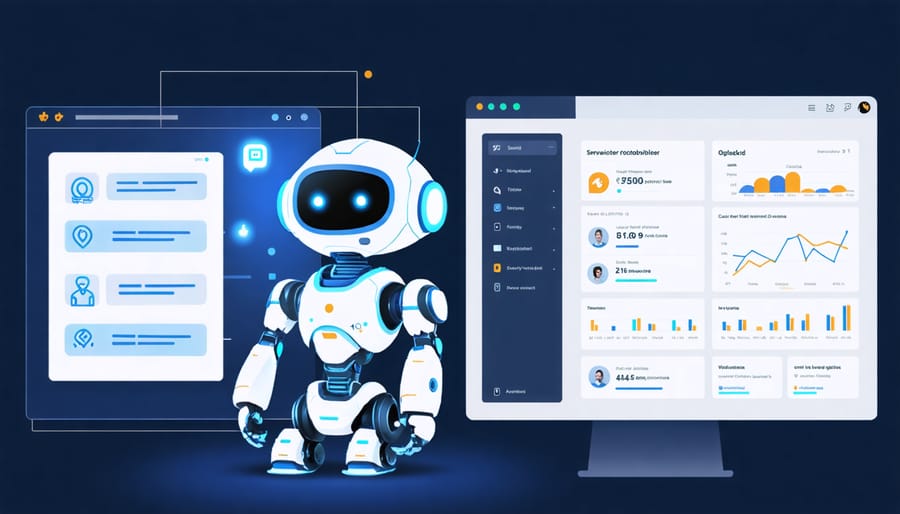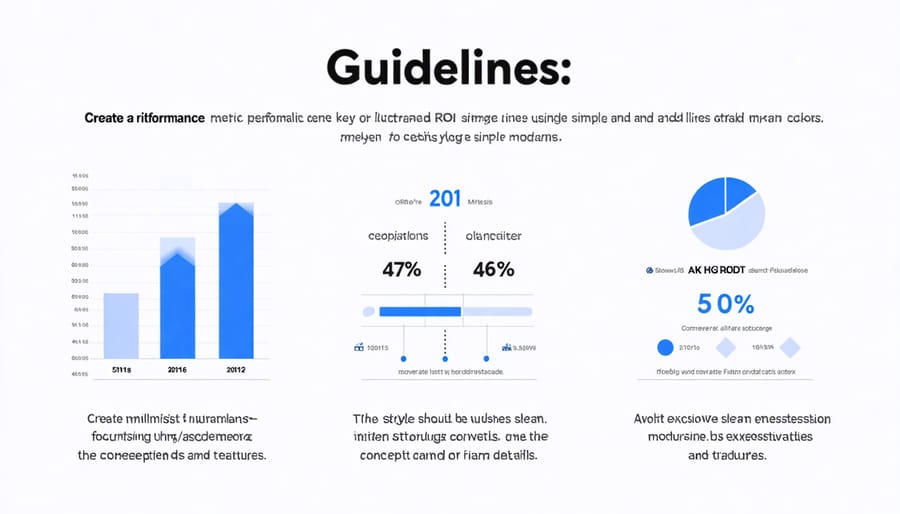AI-Powered Customer Engagement That Actually Drives Sales Results

Transform customer relationships into lasting partnerships through modern customer engagement strategies that deliver measurable results. Today’s digital landscape demands personalized interactions at scale, real-time response capabilities, and data-driven decision-making to maintain competitive advantage.
By leveraging artificial intelligence and automation, businesses now capture customer insights with unprecedented precision, enabling hyper-targeted communication that resonates with specific audience segments. This strategic approach not only increases customer lifetime value but also drives sustainable growth through improved retention rates and enhanced brand loyalty.
The shift from traditional engagement methods to AI-powered solutions represents more than technological advancement—it’s a fundamental reimagining of how businesses connect with their customers. Companies implementing these solutions report up to 40% higher customer satisfaction scores and a 25% increase in revenue from existing customers.
Whether you’re a startup founder or an established enterprise, the key to success lies in adopting engagement strategies that blend human insight with technological innovation. This comprehensive guide will show you how to implement these powerful tools while maintaining the authentic relationships your customers value.

How AI Transforms Traditional Customer Engagement
Real-Time Personalization at Scale
In today’s digital landscape, personalization at scale has become a game-changer for businesses seeking to enhance customer engagement. AI-powered systems analyze vast amounts of customer data in real-time, enabling companies to deliver tailored experiences across multiple touchpoints simultaneously.
These intelligent systems track customer behavior, preferences, and interaction history to create dynamic user profiles. This allows businesses to automatically adjust content, product recommendations, and communication styles based on individual customer characteristics. Whether through email, social media, website experiences, or mobile apps, AI ensures consistency while maintaining personalization across all channels.
The real power lies in the system’s ability to learn and adapt continuously. As customers interact with your brand, the AI refines its understanding and improves its recommendations. This creates a feedback loop that becomes more accurate over time, leading to higher engagement rates and customer satisfaction.
By implementing real-time personalization, businesses can:
– Deliver relevant product recommendations
– Adjust messaging based on customer lifecycle stage
– Customize content according to browsing behavior
– Optimize timing for customer communications
– Scale personal interactions without increasing staff
Predictive Analytics for Customer Behavior
Modern businesses are leveraging predictive analytics to stay one step ahead of customer needs and behaviors. By analyzing historical data, purchase patterns, and online interactions, AI-powered systems can forecast customer actions with remarkable accuracy. This enables businesses to create personalized experiences and timely interventions that drive engagement and sales.
Key benefits include the ability to identify potential churners before they leave, recommend products based on browsing history, and optimize email campaign timing for maximum impact. For example, AI can determine when a customer is most likely to make a purchase and trigger relevant promotions at precisely the right moment.
To implement predictive customer behavior analysis effectively, start by:
– Collecting and organizing your customer data from multiple touchpoints
– Identifying specific behaviors you want to predict
– Setting up automated response systems for different scenarios
– Regularly testing and refining your predictive models
Remember to maintain transparency with customers about data usage and ensure compliance with privacy regulations. The goal is to enhance the customer experience through smart predictions while building trust and maintaining ethical standards.
Implementing AI-Enhanced Customer Engagement Tools
Chatbots and Virtual Assistants
Chatbots and virtual assistants have revolutionized customer engagement by providing 24/7 support and instant responses to common inquiries. These AI-powered tools can handle multiple conversations simultaneously, reducing wait times and improving customer satisfaction while freeing up human agents for more complex issues.
To implement chatbots effectively, start by identifying your most frequent customer inquiries and support requests. Use this data to create a comprehensive knowledge base that your chatbot can draw from. Modern AI chatbots can understand context, remember previous interactions, and provide personalized responses based on customer history.
Consider implementing a hybrid approach where chatbots handle initial inquiries and seamlessly transfer complex cases to human agents. This ensures efficient resolution while maintaining the personal touch when needed. Key features to look for in a chatbot solution include natural language processing, multi-language support, and integration capabilities with your existing customer relationship management (CRM) system.
Virtual assistants can be programmed to proactively engage customers, offering product recommendations, appointment scheduling, and order tracking updates. They can also collect valuable customer feedback and data, helping you identify trends and improvement opportunities.
To maximize effectiveness, regularly update your chatbot’s knowledge base and monitor its performance metrics, including response accuracy, customer satisfaction rates, and resolution times. This continuous improvement approach ensures your automated support system remains relevant and helpful to your customers.

Automated Email and Social Media Response Systems
Modern businesses are increasingly turning to automated systems to manage their digital communications effectively. AI-powered email and social media response tools can significantly improve response times and maintain consistent engagement across multiple channels. These systems use natural language processing to understand customer inquiries and provide relevant, personalized responses instantly.
Key features of automated response systems include message prioritization, sentiment analysis, and customizable response templates. For email management, these tools can categorize incoming messages, route them to appropriate departments, and send automated acknowledgments while ensuring human oversight for complex issues. On social media platforms, AI tools can monitor mentions, comments, and direct messages, responding to common queries and flagging important conversations for personal attention.
To implement these systems effectively, businesses should start by analyzing their most common customer interactions and creating detailed response templates. Regular review and refinement of automated responses ensure they remain relevant and helpful. Many platforms also offer analytics capabilities, allowing businesses to track response times, customer satisfaction levels, and engagement metrics to continuously optimize their communication strategy.
Remember to maintain a balance between automation and human interaction, using AI tools to handle routine inquiries while preserving personal touch for more complex or sensitive communications.
Customer Data Analysis Platforms
Modern customer data analysis platforms leverage AI to transform raw data into actionable insights, enabling businesses to make data-driven decisions about customer engagement. These platforms collect and analyze customer interactions across multiple touchpoints, including social media, email, website behavior, and purchase history.
Key features of these platforms include predictive analytics, which forecasts customer behavior and identifies potential churn risks, and sentiment analysis, which gauges customer satisfaction through feedback and social media mentions. Advanced segmentation capabilities allow businesses to create highly targeted customer groups based on behavior patterns, preferences, and engagement levels.
Real-time analytics dashboards provide immediate visibility into customer interactions, enabling quick response to emerging trends or issues. Machine learning algorithms continuously refine these insights, improving accuracy over time and automatically adjusting customer segments based on evolving behaviors.
For small to medium businesses, these platforms offer scalable solutions that grow with their needs, from basic customer profiling to sophisticated behavioral analysis. Many platforms now include built-in automation features that can trigger personalized communications based on specific customer actions or data patterns.
Measuring AI Engagement Success

Key Performance Indicators
Tracking the right metrics is crucial for measuring the success of your AI-enhanced customer engagement initiatives. Here are the essential KPIs that every business should monitor:
Customer Satisfaction Score (CSAT): Measure how satisfied customers are with their AI interactions through post-engagement surveys. Aim for a score of 85% or higher to ensure your AI solutions are meeting customer expectations.
Response Time: Track the average time taken to address customer queries. AI systems should maintain response times under 30 seconds for initial interactions while ensuring accuracy and relevance.
Resolution Rate: Monitor the percentage of inquiries successfully resolved by AI without human intervention. A healthy first-contact resolution rate typically ranges from 70-80%.
Customer Engagement Rate: Measure how actively customers interact with your AI tools, including chatbot usage, recommendation clicks, and personalized content engagement. Look for steady growth in engagement metrics month over month.
Customer Lifetime Value (CLV): Track changes in CLV after implementing AI engagement solutions. This indicates the long-term impact of your AI strategy on customer relationships and revenue.
Conversion Rate: Monitor the percentage of AI-assisted interactions that lead to desired outcomes, such as sales or sign-ups. Compare these rates with traditional channels to validate AI effectiveness.
Churn Rate: Keep track of customer retention and identify any correlation between AI interactions and customer churn. A decrease in churn rate can indicate successful AI implementation.
Remember to regularly review these metrics and adjust your AI engagement strategy based on the insights gathered. Set benchmarks for each KPI and establish a systematic review process to ensure continuous improvement.
ROI Calculation Framework
To effectively evaluate your AI-driven customer engagement initiatives, establishing a robust ROI calculation framework is essential. Start by identifying key performance indicators (KPIs) that align with your business objectives, such as customer lifetime value (CLV), conversion rates, and customer satisfaction scores.
Create a baseline measurement of these metrics before implementing AI solutions. This foundation is crucial for measuring marketing ROI accurately and tracking improvements over time.
Calculate your ROI using this formula:
ROI = [(Revenue Generated – Total Investment) / Total Investment] x 100
Consider both direct and indirect benefits:
– Direct benefits: increased sales, reduced customer service costs
– Indirect benefits: improved customer satisfaction, enhanced brand loyalty
Track these specific metrics:
1. Customer acquisition cost (CAC)
2. Response time improvement
3. Customer retention rates
4. Cross-selling success rates
5. Customer engagement scores
Remember to factor in all costs:
– Initial AI implementation
– Ongoing maintenance
– Staff training
– System upgrades
– Integration expenses
Review your ROI calculations quarterly and adjust your strategy based on the data. This iterative approach ensures your AI investments continue to deliver maximum value while maintaining optimal customer engagement levels.
Common Implementation Challenges and Solutions
Data Integration Issues
Effective data integration is crucial for enhancing customer engagement, but many businesses struggle with fragmented data sources and inconsistent information. To overcome these challenges, start by conducting a thorough audit of your existing data sources, including CRM systems, social media platforms, and customer service records.
Create a unified customer data platform (CDP) that centralizes all customer information. This consolidation enables a single source of truth and helps maintain data accuracy across all touchpoints. Implement strict data validation rules and regular cleaning processes to ensure data quality remains high.
Address data silos by establishing clear protocols for data sharing between departments. Use API integrations where possible to automate data flow between different systems, reducing manual entry errors and ensuring real-time updates. Consider implementing middleware solutions that can bridge gaps between incompatible systems.
Privacy compliance is another critical aspect of data integration. Ensure your data collection and storage practices align with relevant regulations like GDPR and CCPA. Document your data handling procedures and regularly update them as regulations evolve.
To maintain data integrity, establish a regular audit schedule and assign data stewards within your organization. These individuals should oversee data quality, manage access permissions, and ensure consistent data formatting across all platforms. Regular training sessions for staff handling customer data will help maintain standards and reduce errors.
Staff Training and Adoption
Successful implementation of customer engagement strategies requires a well-structured staff training program and clear adoption protocols. Begin by creating a comprehensive training schedule that introduces team members to new engagement tools and technologies gradually, preventing overwhelm and ensuring proper skill development.
Start with basic functionality training, then progress to advanced features as team members become more comfortable. Assign training champions within each department who can provide peer support and maintain enthusiasm for the new systems. These champions should receive additional training and act as the first point of contact for questions or concerns.
Establish clear performance metrics and expectations for team members using the new engagement tools. Create standard operating procedures (SOPs) that outline best practices, response times, and communication guidelines. Regular feedback sessions help identify areas where additional training may be needed and allow team members to share their experiences and suggestions.
To facilitate adoption, implement a rewards system that recognizes team members who effectively utilize the new engagement strategies. Consider gamification elements to make the learning process more engaging and competitive. Regular refresher sessions keep skills sharp and introduce updates or new features as they become available.
Monitor adoption rates and address resistance promptly through one-on-one conversations and additional support. Document success stories and share them across teams to demonstrate the positive impact of proper implementation on customer satisfaction and business outcomes.
Enhancing customer engagement is no longer optional in today’s digital marketplace – it’s essential for business survival and growth. By implementing the strategies discussed throughout this article, you can create meaningful connections with your customers while streamlining your operations through automation and AI-powered solutions.
Start by assessing your current engagement levels and identifying key areas for improvement. Focus on personalizing customer interactions, leveraging data analytics for better decision-making, and implementing omnichannel communication strategies. Remember that successful customer engagement is an ongoing process that requires constant monitoring and adjustment.
Take these actionable steps to begin your enhancement journey:
1. Audit your existing customer touchpoints
2. Select and implement appropriate engagement tools
3. Train your team on new systems and processes
4. Establish clear metrics for measuring success
5. Regularly collect and analyze customer feedback
Don’t try to implement everything at once. Begin with one or two initiatives that align with your most pressing business needs and gradually expand your engagement strategy. Prioritize solutions that offer the best balance of impact and ease of implementation for your specific situation.
The future of customer engagement lies in finding the right balance between automated efficiency and genuine human connection. By staying focused on your customers’ needs while embracing innovative technologies, you’ll be well-positioned to build lasting relationships that drive business growth and customer loyalty.
Leave a Reply